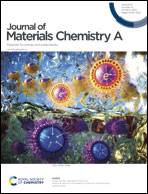The BaCe0.16Y0.04Fe0.8O3−δ nanocomposite: a new high-performance cobalt-free triple-conducting cathode for protonic ceramic fuel cells operating at reduced temperatures†
Abstract
Compared with conventional oxygen-ion-conducting solid oxide fuel cells (O–SOFCs), proton ceramic fuel cells (PCFCs) are more attractive for low-temperature operation due to their smaller activation energy and higher ionic conductivity at reduced temperatures. However, most of the PCFCs still exhibit lower power outputs than O–SOFCs until now due to the lack of suitable and high-performance cathode materials. Cobalt (Co)-based perovskite oxides have been widely employed as cathodes for PCFCs, and suffer from poor thermo-mechanical compatibility with the electrolyte and inferior structural stability. Herein, Co-free triple-conducting perovskite-based nanocomposites are reported as highly active and stable cathodes for PCFCs. By tailoring the Ce/Y co-doping amounts in BaFeO3−δ, Ba(Ce0.8Y0.2)xFe1−xO3−δ (x = 0.1, 0.2 and 0.3) perovskites experience a phase transformation from a single-phase (x = 0.1, O2−/e− conducting) into a composite (x = 0.2 and 0.3, O2−/e− and H+/e− conducting) to achieve triple-conducting capability. The optimized BaCe0.16Y0.04Fe0.8O3−δ nanocomposite cathode displays superior activity for the oxygen reduction reaction (ORR) with low area-specific resistances of 0.27 and 1.49 Ω cm2 at 600 and 500 °C, respectively, surpassing most of the reported Co-free PCFC cathodes. The BaCe0.16Y0.04Fe0.8O3−δ cathode also exhibits superior thermo-mechanical compatibility with BaZr0.1Ce0.7Y0.1Yb0.1O3−δ electrolyte and improved CO2 tolerance due to the strong interaction between O2−/e− and H+/e− conducting phases and the optimized dual-phase composition. Consequently, an anode-supported single cell with the BaCe0.16Y0.04Fe0.8O3−δ cathode delivers a high peak power density of 829 mW cm−2 at 650 °C and a durable operation for ∼450 h at 550 °C. This work provides a highly promising Co-free cathode for PCFCs, which may accelerate the commercialization of this technology.



 Please wait while we load your content...
Please wait while we load your content...